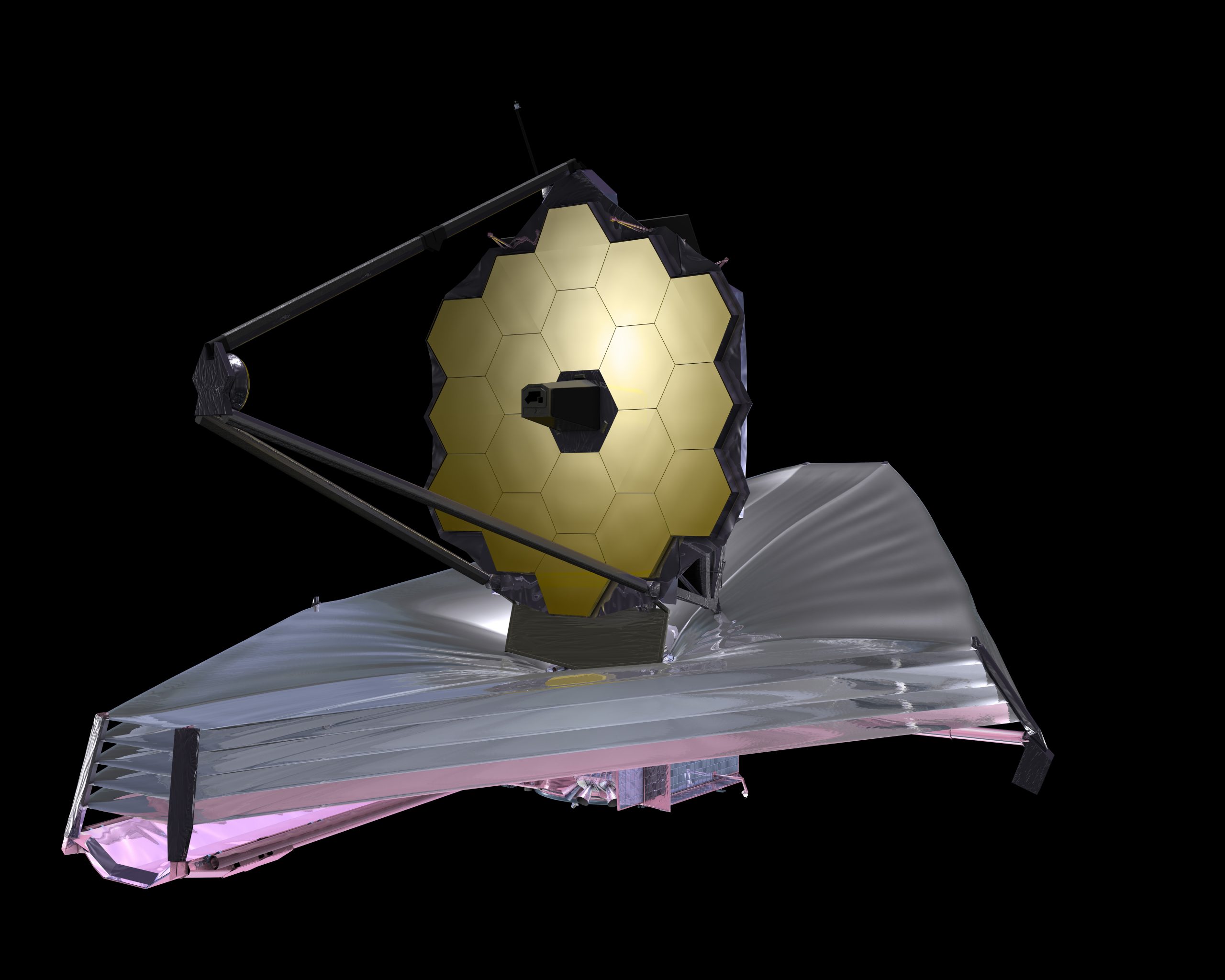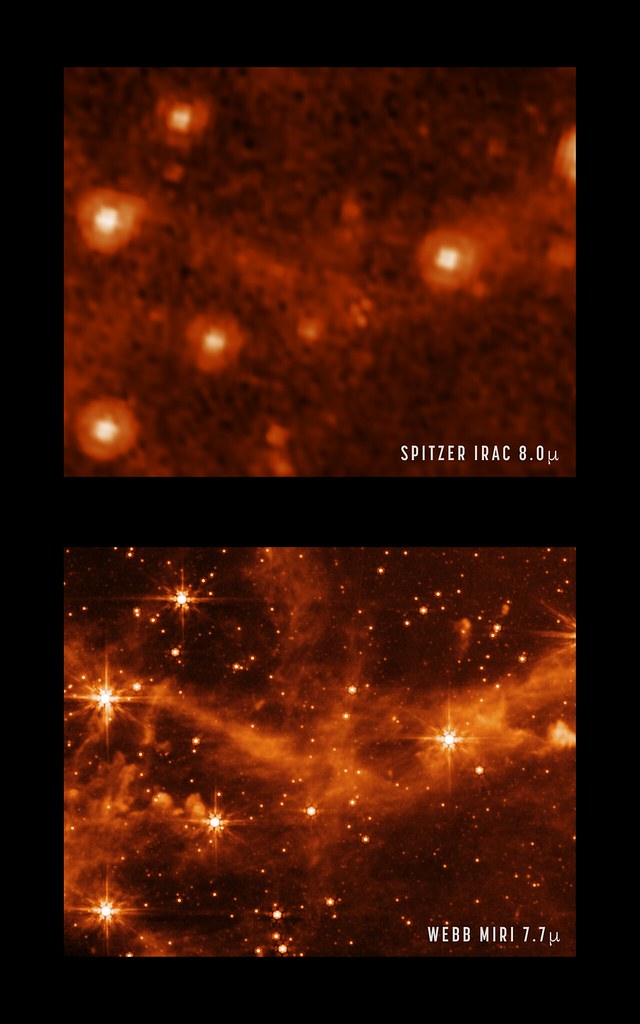The James Webb Space Telescope (JWST) is a 6.5-meter infrared reflecting telescope positioned at the L2 Lagrange point, approximately 930,000 miles from Earth.

Launched on 25 December 2021, the JWST is billed as the successor to the Hubble Space Telescope, and is designed to study the following main scientific research themes:
– first light and reionisation
– the assembly of galaxies
– the birth of stars and protoplanetary systems
– the birth of planetary systems and the origins of life
After a journey of 930,000 miles, the JWST reached its destination on 24 January 2022 and entered full service on 12 July 2022, after a commissioning period that included unfolding its solar array, antenna, sunshield and mirrors.
The JWST should allow us to observe distant galaxies in unprecedented detail. The furthest galaxies are receding away from us at relativistic speeds, due to the expansion of the Universe. This mean that the light we receive from them is red-shifted due to the relativistic Doppler effect (see relativity theory). For this reason, the JWST is mainly designed to observe light from the red end of the visible spectrum to infrared wavelengths, rather than the green and blue parts of the visible spectrum.
The more distant the galaxy, the longer its light has taken to reach us. This means that the furthest galaxies visible to the JWST will appear as they did when the were first forming, less than a billion years after the birth of the Universe.
The JWST will also study the end of the ‘dark ages’ of the Universe from just a few hundred million years after the Big Bang, when the Universe was still opaque to visible light. This is known as the ‘epoch of recombination’ when ions and electrons combined to form electrically neutral atoms, meaning that light was no longer scatted by their electromagnetic fields.
As well as promising to revolutionise our understanding of the evolution of the early Universe, other uses for the JWST include the atmospheric analysis of potentially habitable exoplanets, and in it’s first year of operation, seven percent of the JWST’s time will be used to study objects within our solar system.
The development of the JWST was led by NASA (the U.S. National Aeronautics and Space Administration) in collaboration with the ESA (the European Space Agency) and the CSA (the Canadian Space Agency).
The JWST is named after James Edwin Webb, who served as the second appointed administrator of NASA from February 1961, to October 1968.

Mirror
The JWST’s primary mirror is made up of 18 separate gold-coated beryllium hexagonal mirror segments, and measures a total of 6.5 meters in diameter. For comparison, the mirror of the Hubble Space Telescope is 2.4 meters across. The separate mirror sections must be perfectly aligned to give the clearest, sharpest images.
Instrumentation
The JWST has the following scientific instrumentation:
NIRCam (Near InfraRed Camera) – a near-infrared imager with a range from the edge of the visible spectrum (0.6 μm) through to the near infrared (5 μm).
NIRSpec (Near InfraRed Spectrograph) – an instrument to perform spectroscopy over the same wavelength range as NIRCam.
MIRI (Mid-InfraRed Instrument) – an imager and spectrograph to observe mid to long infrared radiation from 5 to 28 μm.
FGS/NIRISS (Fine Guidance Sensor and Near Infrared Imager and Slitless Spectrograph) – the FGS controls the orientation of JWST and is also used for image stabilisation. This instrument module is combined with NIRISS used for imaging and spectroscopy in the 0.8 to 5 μm wavelength range.
Position
As with the Hubble Space Telescope (HST), the advantage of placing a telescope in space is that the images it produces are not distorted by the Earth’s atmosphere.
Unlike the HST, which is in low-Earth orbit, the Jamee is located at the Earth’s L2 Lagrange point – one of five areas of gravitational equilibrium surrounding a planet that is orbiting a star.
Earth’s L2 position is approximately 930,000 miles (1,500,000 km) from the Earth on the opposite side from the Sun – much further away than the Moon at roughly 250,000 miles from Earth. At this distance, the combined gravitational pull of the Earth and the Sun are just strong enough to balance the centrifugal effect of a satellite.
Normally, the orbital period of an object at this distance from the Sun would be longer than the orbital period of the Earth, but the extra pull from Earth’s gravity increases the orbital speed of the object so that it becomes synchronised with the orbit of the Earth. This keeps the J in a roughly fixed position relative to the Earth as it orbits the Sun.
The L2 position was chosen so that the telescope can be easily shielded from the heat and glare of the Sun, Earth and Moon with its large aluminium-coated plastic sun-shield, roughly the area of a tennis court, always turned towards the sun. This means that the JWST can be cooled to temperatures below 50 Kelvin (-223°C). This is important for infrared astronomy, as otherwise the heat radiation produced from the mirror would overwhelm the telescope’s infrared instrumentation.
These factors, combined with the large size of the JWST’ primary mirror, mean it has an unparalleled view of the Universe.
Rather than being positioned at the exact centre of the L2 point, the JWST circles its Lagrange point in what’s known as a halo orbit. This is so that it’s solar panel array is never in the shadow of the Earth or the Moon.
L2 is a point of unstable equilibrium, meaning that the JWST must expend fuel for stationkeeping, so that it doesn’t drift slowly out of position. The JWST will fire its thrusters every 21 days to keep its orbit, until it runs out of fuel.
The JWST should have enough fuel to maintain its position for around 20 years. This is higher than the original expectation of around 10 years, due to the efficiency of the launch and the need for fewer course corrections than expected on the JWST’s roughly 30-day journey to its Lagrange point.
At this distance from the Earth, however, it will not be possible to send a mission to carry out repairs to the JWST if it were to malfunction.
The Lagrangian points are named after Joseph-Louis Lagrange who proposed the existence of the L4 and L5 points in 1772, while the L1, L2 and L3 points had been discovered by Leonhard Euler in around 1750.